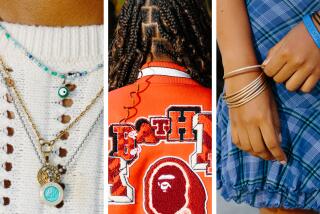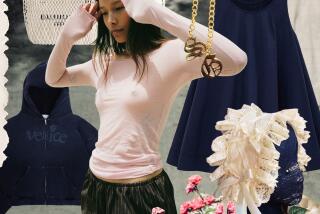Rules of the Road
A lovely young woman leans against the back of the sofa and shivers. It’s a delicious shiver, the sort that high school girls might use to lure the jackets off the backs of nearby football players, the same shiver that some women use to encourage an embrace at patio cocktail parties. Eventually age or motherhood removes it from the repertoire of seduction. But our lovely young woman is still young enough to shiver deliciously--and she has reason. Clad in a pair of hip-hugger trousers and a houndstooth vest with a sheer beaded back, much of her torso is bare, despite it being a winter month and quite chilly. And hers are not the only bare arms and belly in the room. Although it’s cold, it’s also Los Angeles, and our propensity for automotive travel lets us ignore the weather.
Among Easterners, it has been suggested that Los Angeles is an alternate universe, and, to a certain extent, it is--a universe dictated by the convenience and limitations of the automobile.
And it shows in our clothes. Especially women’s clothes.
We wear sandals in November, go bare-legged on New Year’s Eve. We don’t believe much in coats, and the men among us will pull on shorts, even for semiformal events, at the drop of a hat. Not that there are many hats around to drop, unless it’s the ubiquitous baseball cap. As accessories, some women carry handbags the size of cell phones and dogs the size of purses, while others shoulder purses that look more like luggage and backpacks suitable for a weeklong jaunt into the outback--chiropractic concerns are minimal when you’re only walking one block from the parking garage to the office.
“You really can go from the bedroom to the car to your destination with virtually no steps in between,” says Julie Gilhart, vice president of fashion merchandising for Barneys New York. “In Los Angeles, you just don’t need as many pieces, which is why the idea of wearing just a great top with a bottom came out of L.A. You don’t need a scarf or a jacket or a hat.”
In defiance of dress codes and decorum, we wear stilettos to the office with clothing so short and tight and tiny that sudden movement renders it superfluous. According to Kim Sobel, a spokeswoman for Banana Republic, sleeveless and short-sleeve tops and dresses sell pretty much year-round in L.A. We don’t worry about layering or finding that little go-everywhere frock; in dress-down L.A., almost everything goes everywhere, and if we need to change, we’ll drive home before heading out to dinner. Should traffic prove an obstacle, we’ll just change in the car. Any woman with any kind of social life has at least two spare outfits in her back seat, if only because she keeps forgetting to bring in the dry cleaning.
“In L.A., women have so much more freedom,” says Mark Buettell, manager of the Christian Louboutin shoe store in Beverly Hills. “They don’t have to worry about what’s sturdy or what wears well on the subway. In New York, there’s more of a uniform, women wear layers to take them through the day. But here, you can go home or keep an outfit in the car.” Louboutin and his like may well be the biggest beneficiaries of car couture. His are not so much shoes as podiatric confections. With winkle-picker toes (able to kick a spider wedged into the tightest corner) and heels the height and width of a Virginia Slim, a Louboutin shoe is made mostly of air. The additional materials appear to be a bit of silk, a few feathers, a wisp of leather and a satin bow. And Angelenos love them.
According to Buettell, who has also worked for Barneys and Gucci, there are more high heels sold in Los Angeles than in any other U.S. city, including New York. Those “Sex and the City” girls may fornicate like New Yorkers, but their footwear is strictly L.A. In New York, Buettell says, women might take sexy shoes to work and change before going out, but in L.A., they just wear those Manolo stilettos all day long. “Here you see more delicate styles, more beading,” he said. “Shoes don’t have to be practical at all--no one’s walking 16 blocks to the subway and back.”
Which may explain the fairly recent phenomenon of platform tennis shoes. Suitable for neither work nor play, they dominate shoe stores all around the city, leaving space enough only for the now-ubiquitous black platform sandal that women of a certain age, either actual or desired, wear year-round. According to Buettell, L.A. is a year-round sandal market, with Labor Day just another excuse for a barbecue.
The popularity of sandals could be graphed in direct proportion to the avoidance of pantyhose. Now on the list of life-choice motivators, pantyhose is right up there with Need to Change the World and How Can I Really Make My Mother Mad? A young woman I know became a surgeon mainly because she was fairly certain that surgeons never had to wear pantyhose; I became a journalist for much the same reason. For those contemplating a move to Los Angeles, it can be the final deal-clincher: Come here and you’ll never have to see another reinforced toe in your life.
In other cities, whole floors of department stores are devoted to hose and tights; here you’re lucky to find one lousy three-tiered kiosk. And this demand-based supply trickles down to the toddler set. A mother I know--in fact she has credit cards in my name-- found herself dashing wild-eyed through a mall scant minutes before Christmas in search of a pair of simple black tights for her 20-month-old. In store after store, there were none to be found. In Gymboree, she was shown to an aisle devoted to leggings and bicycle shorts. Bicycle shorts. For toddlers. Two days before Christmas. Apparently that’s what every 2-year-old Angeleno is wearing under her red plaid crinolined party dress--bicycle shorts. What we save on pantyhose, we no doubt spend on therapy.
Hoisery companies are not the only ones who suffer from the vagaries of Angeleno style. When Carrie Kneitel and her partner decided to create Edward An, a coat company, they figured it was exactly what this town needed. Heaven knows there are enough ugly coats here to save seats for every Orc in Middle-earth. Each year, nights grow cold in L.A. much as they do in the rest of the world, and, each year, Angelenos are shocked and somewhat irritated by this fact.
But Kneitel had a harder time getting the business going than she expected. While the coat is the keystone of the winter wardrobe in other cities, it is too often an afterthought here. We grope about in our closets and pull out pilled-up polar fleece from Old Navy, oversized black leather coats that do not make anyone look like Samuel L. Jackson except Samuel L. Jackson and those unfortunate sequined jean jackets that so many of us are inexplicably hanging on to. The coat in any form, after all, is antithetical to the city’s raison d’etre.
“In L.A., we try to show as much skin as we can,” she says, “and we’re taking the angle that it’s sexy to wear a coat. It was difficult at first.” Barneys’ Gilhart agrees. “You have to think in terms of lighter fabrics, and almost always unlined. Very light cashmere is popular in L.A. In other cities you need coats that can take you down the streets through the weather.”
Bulky coats are also a turnoff for folks sliding in and out of the front seat, which is why Kneitel’s Edward An coats, available at Fred Segal and American Rag, are, for the most part, lightweight and tailored. Last year’s line included a Mac-in-Pack (an unlined Macintosh that folded into a briefcase-type packet that could easily be tucked in the car) and this spring Edward An is bringing out its version of the driving coat--an above-the-hip, tight-fitting blazer.
The car coat may be the best example of how the physical environment of the car has created a new look. The wind-whipped, convertible scarf, a la Grace Kelly in “To Catch a Thief” (and as spoofed by Renee Zellweger in “Bridget Jones’s Diary”), is another. And, of course, the increasingly popular driving shoe--everyone from L.L. Bean to Barneys is getting in on the act--is in an eyebrow-raising class all its own.
But besides offering freedom from weather and wardrobe limitations, the car has a few fashion dictates as well. Seatbelts ratchet the wrinkle factor higher than that of public transportation, and so many women eschew the linen suit, or even the silk blouse. Our driving habits also tend to show the moment we get out of the car--a shower of crumbs, a smear of jelly on the lap instantly reveals a breakfast on the go. And what smoker hasn’t suffered that AWOL cigarette burn through the folds of a cuff or skirt?
While auto designers have perfected the cup holder so that not one drop of Thai iced tea escapes en route, all bets are off when the cup leaves the holder. One woman I know has taken to drinking her hot coffee through a straw to avoid inter-freeway spills. A practical solution, but it does lend a Big Gulp atmosphere to even the frothiest cappuccino, and that can’t be what the Italians had in mind.
Perhaps what Angelenos really need is a short, transparent coat. It could provide some insulation against those spring rains (another inevitability that pulls us up short) while allowing Pilates-toned arms and bellies to strut their stuff. More important, it could be quickly wiped clean after every commute.
Throw on a few feathers and a satin bow, and they should sell like hot cakes.
*
Mary McNamara is a Times staff writer. She last wrote for the magazine about a day in the life of a 3-year-old boy.







